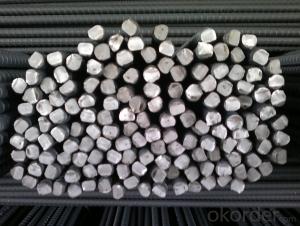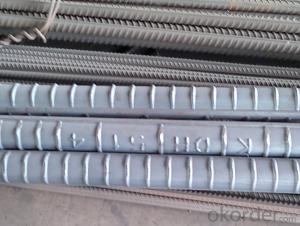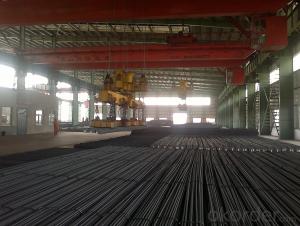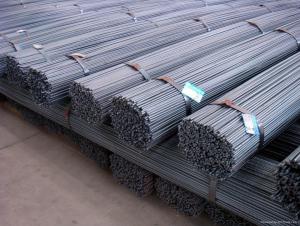GB Standard HRB400, 500 Hot Rolled Deformed Steel Rebars
- Loading Port:
- Shanghai
- Payment Terms:
- TT or LC
- Min Order Qty:
- 100 m.t.
- Supply Capability:
- 200000 m.t./month
OKorder Service Pledge
OKorder Financial Service
You Might Also Like
OKorder is offering GB Standard HRB400, 500 Hot Rolled Deformed Steel Rebars at great prices with worldwide shipping. Our supplier is a world-class manufacturer of steel, with our products utilized the world over. OKorder annually supplies products to African, South American and Asian markets. We provide quotations within 24 hours of receiving an inquiry and guarantee competitive prices.
Product Applications:
GB Standard HRB400, 500 Hot Rolled Deformed Steel Rebars are ideal for structural applications and are widely used in the construction of buildings and bridges, and the manufacturing, petrochemical, and transportation industries.
Product Advantages:
OKorder's GB Standard HRB400, 500 Hot Rolled Deformed Steel Rebars are durable, strong, and wide variety of sizes.
Main Product Features:
· Premium quality
· Prompt delivery & seaworthy packing (30 days after receiving deposit)
· Can be recycled and reused
· Mill test certification
· Professional Service
· Competitive pricing
Product Specifications:
Manufacture: Hot rolled
Grade: HRB400 500etc
Certificates: ISO, SGS, BV, CIQ
Length: 6m – 12m, as per customer request
Packaging: Export packing, nude packing, bundled
Deformed Steel Bar | ||
Diameter (MM) | Cross Sectional Area (MM2) | Theorectical Weight (KG/M) |
6 | 28.27 | 0.222 |
8 | 50.27 | 0.395 |
10 | 78.54 | 0.617 |
12 | 113.1 | 0.888 |
14 | 153.9 | 1.21 |
16 | 201.1 | 1.58 |
18 | 254.5 | 2 |
20 | 314.2 | 2.47 |
22 | 380.1 | 2.98 |
25 | 490.9 | 3.85 |
28 | 615.8 | 4.83 |
32 | 804.2 | 6.31 |
36 | 1018 | 7.99 |
40 | 1257 | 9.87 |
HRB335
Grade | Technical data of the original chemical composition (%) | |||||||
C | Mn | Si | S | P | B | |||
HRB335 | ≤0.25 | ≤1.60 | ≤0.80 | ≤0.045 | ≤0.045 | >0.0008 | ||
Physics capability | ||||||||
Yield Strength(N/cm2) | Tensile Strength(N/cm2) | Elongation (%) | ||||||
≥335 | ≥490 | ≥16 | ||||||
HRB400
Grade | Technical data of the original chemical composition (%) | |||||||
C | Mn | Si | S | P | V | |||
HRB400 | ≤0.25 | ≤1.60 | ≤0.80 | ≤0.045 | ≤0.045 | 0.04-0.12 | ||
Physics capability | ||||||||
Yield Strength(N/cm2) | Tensile Strength(N/cm2) | Elongation (%) | ||||||
≥400 | ≥570 | ≥14 | ||||||
FAQ:
Q1: Why buy Materials & Equipment from OKorder.com?
A1: All products offered byOKorder.com are carefully selected from China's most reliable manufacturing enterprises. Through its ISO certifications, OKorder.com adheres to the highest standards and a commitment to supply chain safety and customer satisfaction.
Q2: How do we guarantee the quality of our products?
A2: We have established an advanced quality management system which conducts strict quality tests at every step, from raw materials to the final product. At the same time, we provide extensive follow-up service assurances as required.
Q3: what is the difference between actual weight and theoretical weight?
A3: All the section steel has two weights: actual weight and theoretical weight. Actual weight is the weighing out when the product delivered from the mill. Theoretical weight is calculated by pieces. The invoice can be based on each of them as your request.
Images:
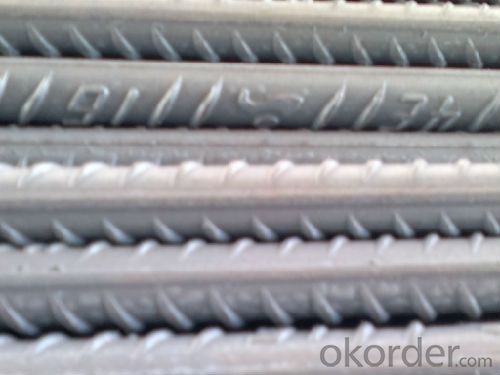
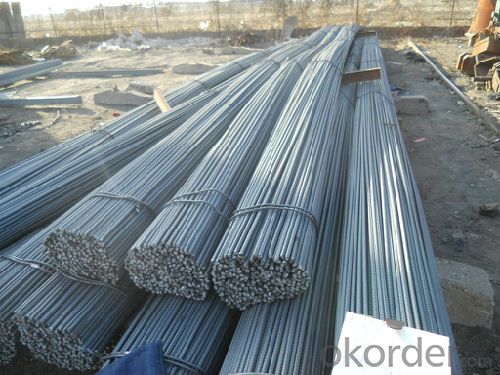
- Q: What is the typical weight of a steel rebar?
- The weight of a steel rebar can vary depending on its diameter and length, resulting in different typical weights. However, in construction projects, the most commonly used steel rebar is usually 20 feet long and has a diameter ranging from 1/2 inch to 1 inch. In terms of weight, this standard size can range from approximately 7.5 pounds to 24 pounds per linear foot. Consequently, a 20-foot steel rebar can weigh anywhere between roughly 150 pounds to 480 pounds. It is worth noting that weight standards for steel rebars may differ between countries, so it is always recommended to refer to local specifications and standards for accurate information.
- Q: What is the role of steel rebars in column and beam construction?
- Steel rebars are essential in column and beam construction because they provide reinforcement, strength, and stability to the structure. In reinforced concrete construction, columns and beams are typically made of strong concrete that is weak in tension. This is where steel rebars come into play. Rebars, also known as reinforcing bars, are long steel rods strategically placed within the concrete to counteract its weakness in tension. They are made of high-strength steel and designed to withstand the tensile forces in a structure. By adding rebars to the concrete, the resulting composite material becomes capable of resisting both compression and tension, making it stronger and more durable. In column construction, steel rebars are vertically placed and tied together in a grid-like pattern. This reinforcement helps the column support the weight of the structure and resist vertical loads such as the weight of the floors or roof above. The rebars also prevent the column from buckling or collapsing under these loads. Similarly, in beam construction, steel rebars are horizontally placed within the concrete beam. These rebars assist the beam in resisting bending and shear forces, which are common in structural elements spanning across openings or supporting loads from above. By providing reinforcement, the rebars ensure that the beam remains stable and can safely bear the imposed loads. Overall, steel rebars enhance the strength, stability, and load-bearing capacity of columns and beams in construction. They improve the structural integrity of concrete elements, allowing them to withstand various forces and loads throughout their lifespan. Without rebars, columns and beams would be weaker and more prone to failure, compromising the safety and longevity of the entire structure.
- Q: How do steel rebars affect the overall energy efficiency of a structure?
- Steel rebars can positively affect the overall energy efficiency of a structure by enhancing its structural integrity and reducing the risk of structural failure. By reinforcing concrete, rebars help to distribute loads evenly, improving the building's resilience against various forces such as earthquakes and heavy winds. This increased durability can lead to a longer lifespan, reducing the need for frequent repairs or reconstructions, which in turn saves energy and resources. Additionally, by enabling the construction of taller and more efficient buildings, steel rebars contribute to the optimized use of land and resources, ultimately enhancing the overall energy efficiency of the structure.
- Q: Are there any disadvantages or limitations of using steel rebars?
- Yes, there are some disadvantages or limitations of using steel rebars. Firstly, steel rebars are prone to corrosion when exposed to moisture or harsh environmental conditions, which can weaken the structure over time. Secondly, steel rebars are heavy and require heavy machinery for transportation and installation, making them less suitable for certain construction projects. Additionally, steel rebars can cause electromagnetic interference, which can interfere with electronic devices or communication systems in some cases. Lastly, steel rebars have a high thermal conductivity, which can result in energy losses or thermal bridges if not properly insulated.
- Q: Can steel rebars be used in structures with high electromagnetic shielding requirements?
- To a certain extent, structures with high electromagnetic shielding requirements can make use of steel rebars. Steel is inherently conductive, meaning it can redirect and absorb electromagnetic waves, which is why steel rebars are beneficial for reducing the infiltration of electromagnetic radiation into structures. Nevertheless, it is important to consider that the effectiveness of steel rebars in providing electromagnetic shielding relies on various factors. The thickness and quality of the steel rebars, the design and construction of the structure, and the frequency and intensity of the electromagnetic waves all contribute to determining the level of shielding that can be achieved. In situations where extremely high electromagnetic shielding requirements are necessary, additional measures may be required. These measures may involve the utilization of specialized materials that are specifically designed for electromagnetic shielding, such as conductive coatings or composite materials with high conductivity. Furthermore, it is crucial to take into account the overall design and construction of the structure to ensure that the steel rebars are properly grounded. Proper grounding facilitates the safe channeling and dissipation of electromagnetic energy, preventing the accumulation of potentially hazardous electromagnetic fields. In conclusion, although steel rebars can contribute to electromagnetic shielding in structures, the level of shielding provided can vary depending on multiple factors. For structures with stringent electromagnetic shielding requirements, it is advisable to seek guidance from experts in the field to determine the most suitable materials and construction techniques.
- Q: What are the different grades of steel rebars used in bridge construction?
- The different grades of steel rebars used in bridge construction vary depending on the specific requirements and design specifications of the bridge. Common grades include Grade 40, Grade 60, and Grade 75. These grades indicate the minimum yield strength of the steel rebar, with higher grades offering greater strength. The choice of grade depends on factors such as the anticipated loads, span length, and structural design of the bridge.
- Q: Are there any specific guidelines for storing and handling steel rebars?
- Yes, there are specific guidelines for storing and handling steel rebars. These guidelines typically include storing rebars on a flat surface to prevent bending and distortion, keeping them off the ground to prevent rusting, and protecting them from moisture and exposure to chemicals. Additionally, rebars should be handled with care to avoid any damage or injury, and they should be stored in a well-organized manner to ensure easy identification and retrieval.
- Q: What are the advantages of using stainless steel rebars?
- Using stainless steel rebars in construction projects offers several advantages. Firstly, these rebars have a remarkable resistance to corrosion, making them perfect for structures in harsh environments such as coastal or industrial areas. Unlike traditional carbon steel rebars, stainless steel rebars do not easily rust or corrode, ensuring the durability and longevity of the structure. Secondly, stainless steel rebars possess a higher tensile strength compared to carbon steel rebars. This means they can endure greater stress and loads without deforming or breaking, resulting in a safer and more reliable structure. Moreover, their high tensile strength allows for the utilization of smaller rebars, which saves construction costs and reduces the overall weight of the structure. Furthermore, stainless steel rebars exhibit excellent fire resistance properties. They retain their strength and integrity much better than carbon steel in the event of a fire, reducing the risk of structural collapse. This is particularly crucial in buildings with high fire safety requirements, such as hospitals, schools, and high-rise structures. Another advantage of stainless steel rebars is their low maintenance requirements. Due to their corrosion resistance, they do not need regular inspections or costly protective coatings. This saves both time and money in maintenance efforts. Lastly, stainless steel rebars are highly sustainable and environmentally friendly. They are 100% recyclable, reducing the demand for new raw materials and minimizing waste in construction projects. Additionally, the long lifespan of stainless steel rebars reduces the need for frequent replacements, further minimizing the environmental impact. To summarize, the benefits of using stainless steel rebars include excellent corrosion resistance, high tensile strength, superior fire resistance, low maintenance requirements, and sustainability. These advantages make stainless steel rebars the preferred choice for construction projects that prioritize durability, safety, and long-term value.
- Q: What is the process of reinforcing existing concrete structures with steel rebars?
- Enhancing the strength and durability of existing concrete structures with steel rebars involves a series of steps. To begin, a thorough assessment of the concrete structure is conducted to determine its condition and identify areas in need of reinforcement. This involves inspecting the concrete for cracks, signs of degradation, or any other structural issues. Once the areas requiring reinforcement are identified, the next step is surface preparation. This involves cleaning the concrete surface to remove any loose debris, dirt, or contaminants that could hinder the bonding of the rebars with the concrete. Various methods, such as pressure washing or sandblasting, can be used for this purpose. Following surface preparation, the rebars are strategically placed within the concrete structure. The positioning and spacing of the rebars are crucial to ensure optimal reinforcement and structural integrity. This is typically accomplished by drilling holes or creating channels in the concrete where the rebars will be placed. Afterward, the rebars are inserted into the holes or channels, ensuring proper alignment and securing. The rebars are typically cut to the required length and bent into the desired shape to meet the specific reinforcement needs of the structure. Once the rebars are in place, they are anchored or secured to the existing concrete by various means. This can be achieved through the use of epoxy adhesive, mechanical anchors, or embedding the rebars into fresh concrete poured around them. Finally, the concrete is restored to its original condition, covering the rebars and creating a smooth and even surface. This may involve patching up any holes or channels created during the reinforcement process and finishing the surface to match the surrounding concrete. In conclusion, the process of reinforcing existing concrete structures with steel rebars necessitates careful planning, proper surface preparation, precise placement of rebars, secure anchoring, and appropriate finishing to achieve a strengthened and long-lasting structure.
- Q: What are the common factors that can cause premature failure of steel rebars?
- Some common factors that can cause premature failure of steel rebars include corrosion, inadequate concrete cover, improper installation or handling, structural overloading, and exposure to extreme temperatures.
Send your message to us
GB Standard HRB400, 500 Hot Rolled Deformed Steel Rebars
- Loading Port:
- Shanghai
- Payment Terms:
- TT or LC
- Min Order Qty:
- 100 m.t.
- Supply Capability:
- 200000 m.t./month
OKorder Service Pledge
OKorder Financial Service
Similar products
Hot products
Hot Searches
Related keywords
